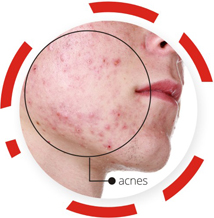 |
 |
| |
Follow us on Facebook and join our Mailing List to receive useful Acne related articles, information and promotions all month long. |
| |
What is Acne? |
|
Acne is a skin disease that involves the oil glands at the base of hair follicles. It commonly occurs during puberty when the oil glands come to life. |
|
Acne is not dangerous, but can leave skin scars. Human skin has pores which connect to oil glands located under the skin. The glands are connected to the pores via follicles - small canals. These glands produce Sebum, an oily liquid. The sebum carries dead skin cells through the follicles to the surface of the skin. A small hair grows through the follicle out of the skin. Pimples grow when these follicles get blocked, resulting in an accumulation of oil under the skin. |
|
In humans, pimples tend to appear on the face, back, chest, shoulders and neck. Simply put - skin cells, sebum and hair can clump together into a plug, this plug gets infected with bacteria, resulting in a swelling. A pimple starts to develop when the plug begins to break down. There are various types of pimples. |
|
|
 |
|
|
| |
 |
| |
|
Whiteheads |
|
Under the skin and are very small |
|
|
|
Blackheads |
|
Clearly visible, black and appear on the surface of the skin |
|
|
|
Pustules |
|
Clearly visible on the surface of the skin (usually red at the base with pus on top) |
|
|
|
Cysts |
|
Clearly visible on the surface of the skin. Generally painful and are filled with pus. |
| |
|
|
|
|
| |
Causes |
|
Nobody is completely sure what causes acne. Experts believe the primary cause is a rise in androgen levels - androgen is a type of hormone. Androgen levels rise when a human becomes an adolescent. Rising androgen levels make the oil glands under your skin grow; the enlarged gland produces more oil. Excessive sebum can break downcellular walls in your pores, causing bacteria to grow. |
|
Some studies indicate that susceptibility to acne could also be genetic. Some medications which contain androgen and lithium may cause acne. Greasy cosmetics may cause acne in some susceptible people. Hormone changes during pregnancy may cause acne to either develop for the first time, or to recur. |
|
A study published in February 2013 has suggested a link between a diet high in glycemic index foods and dairy products. |
|
Sources: Medical News Today, Mayo Clinic, WebMD |
|
| |
 |
| |
Acne treatments work by reducing oil production, speeding up skin cell turnover, fighting bacterial infection, and/or reducing the inflammation |
| |
 |
| |
Topical Medications work by promoting cell turnover and preventing plugging of the hair follicles. A number of topical antibiotics also are available. They work by killing excess skin bacteria. |
| |
Oral Antibiotics and Medications |
Oral Contraceptives |
Best for moderate to severe acne, you may need a short course of prescription oral antibiotics or medications to reduce bacteria and fight inflammation. |
Women’s ovaries and adrenal glands normally produce a low level of androgens however higher levels of androgens can lead to excess sebum. Taking birth control pills that contain both estrogen and progesterone lowers the amount of androgens in your body. This results in less sebum and less severe acne. |
|
| |
 |
| |
Acne scarring can sometimes develop as a complication of acne. Any type of acne spot can lead to scarring, but it is more common when the most serious types of spots (nodules and cysts) burst and damage nearby skin. |
| |
Acne scarring can sometimes develop as a complication of acne. Any type of acne spot can lead to scarring, but it is more common when the most serious types of spots (nodules and cysts) burst and damage nearby skin |
| |
Microdermabrasion |
Chemical peels |
Laser Acne Scar Removal |
A light cosmetic procedure that uses a mechanical medium for exfoliation to gently remove the outermost layer of dead skin cells from the epidermis. Most commonly, microdermabrasion uses two parts: an exfoliating material like crystals or diamond flakes and a machine based suction to gently lift up the skin during exfoliation. |
A body treatment technique used to improve and smooth the texture of the facial skin using a chemical solution that causes the dead skin to slough off and eventually peel off. |
Used to treat mild to moderate acne scarring |
|
| |
|
|
 |
| |
 |
| |
 |
| |

|
| |









